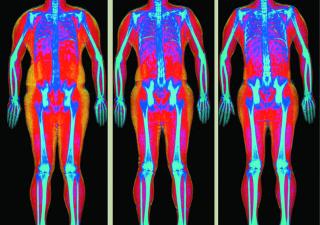Knowing our body composition gives us a valuable window into our health. It tells us what’s in there – the ratios of muscle, bone, fat. Knowing these things tells us a lot about our health – the medical conditions we’re predisposed to and the initiatives we can take to combat them. It’s an early warning system. A technological ‘heads up’ that we need to address lifestyle factors. A list of chronic conditions impacted by body composition reads like the grim reaper’s ‘to do list’.
- Hypertension
- Myocardial Infarction
- Angina and Silent Ischaemia
- Peripheral Arterial Disease
- Chronic Obstructive Pulmonary Disease
- Chronic Restrictive Pulmonary Disease
- Diabetes
- Hyperlipidemia
- Obesity
Measures of body composition are all also a test of the success (or otherwise) of a change in nutritional and physical activity habits. It tells us if we’re on the right track with these lifestyle modifications.
There are a myriad of different ways to measure body composition. But all methods are not created equal. Here, we contrast these methods and examine the literature into which actually tell us ‘what’s in there’.
Methods of Measuring Body Composition
DEXA Scan: The king of body composition measures. Duel-energy X-ray absorptiometry. Offer high accuracy and high replicability. Not only gives percentages of various tissue types, but reveals th distribution patterns. Once you’ve found somewhere to complete a DEXA Scan, the process is very unintrusive.
Hydrostatic Weighing: Before DEXA Scans, this was the gold standard. It involves weighing the body underwater, in a purpose built tank. It works on the premise that different tissue types have different densities. Although this provides a generally accurate measure for the general population, it doesn’t take into account variation in densities in tissue types that exists between subjects.
Bioimpedance: Measuring body composition through bioimpendance involves measuring the rate at which an electrical frequency is passed through the body. The theory is that tissues high in water (muscle) will conduct electricity at a greater rate than those lower in water (fat). Variability occurs due to changes in lifestyle activities (fasted versus unfasted etc), the variables entered by the tester, and the equations used by that particular device. Another limiting factor is the failure of many of these devices to measure abdominal fat – that most closely correlated with chronic disease.
Skin folds: Massive amounts of human error. Two measurements taken minutes apart by the same tester can show large differences, let alone measurements months apart by different testers.
Body Mass Index: BMI = Mass (kg) / height (m) squared. This method of measuring ‘fatness’ fails to take into account actual body composition, and instead aims to place an individual on a continuum of health based purely on weight. Of very little use for most individuals.
Key Points From the Research
- Relative to DEXA Scans, “Bioimpendance tends to overestimate %BF in lean subjects and underestimate %BF in obese subjects.” (1)
- “…DEXA is an accurate method for measurement of soft-tissue body composition.” (2)
- “…reliability was greatest for DXA, followed by BIA and skinfold-thickness measurement. The percentage of fat values for the three methods were highly intercorrelated…” (3)
- For body fat %, “…DEXA values to be higher than those derived from skinfold-thickness measurements…” (3)
- “The advantages of DXA include good accuracy and reproducibility, and provides for the assessment of regional body composition and nutritional status in disease states and growth disorders.” (4)
- “…given its poor accuracy, it remains to be determined if BIA (bioimpedance) can be used to monitor ACPs for changes in total-body tissue composition as a function of time…” (5)
- “…DXA (DEXA Scans) and BIA (Bioimpedance) cannot be used interchangeably in research or clinical settings…” (5)
Case Study:
To compare the two most common methods ourselves (DEXA and Bioimpendance), we sent a 28 year old female to receive both tests on the same day. The results:
- DEXA Scan 26.6% body fat.
- Bioimpendence 21.0% body fat.
References:
- Kim, M., Shinkai, S., Murayama, H., & Mori, S. (2014). Comparison of segmental multifrequency bioelectrical impedance analysis with dual-energy X-ray absorptiometry for the assessment of body composition in a community-dwelling older population. Geriatrics & Gerontology International, 15(8), 1013-1022.
- Svendsen, O. L., Haarbo, J., Hassager, C., & Christriansen, C. (1993). Accuracy of Measurements of Total-Body Soft-Tissue Composition by Dual Energy X-Ray Absorptiometry in Vivo. Human Body Composition, 381-383.
- Pecoraro, P., Guida, B., Caroli, M., Trio, R., Falconi, C., Principato, S., & Pietrobelli, A. (2003). Body mass index and skinfold thickness versus bioimpedance analysis: Fat mass prediction in children. Acta Diabetologica, 40(0).
- Lee, S. Y., & Gallagher, D. (2008). Assessment methods in human body composition. Current Opinion in Clinical Nutrition and Metabolic Care, 11(5), 566-572.
- Trutschnigg, B., Kilgour, R. D., Reinglas, J., Rosenthall, L., Hornby, L., Morais, J. A., & Vigano, A. (2008). Precision and reliability of strength (Jamar vs. Biodex handgrip) and body composition (dual-energy X-ray absorptiometry vs. bioimpedance analysis) measurements in advanced cancer patients. Appl. Physiol. Nutr. Metab. Applied Physiology, Nutrition, and Metabolism, 33(6), 1232-1239.






